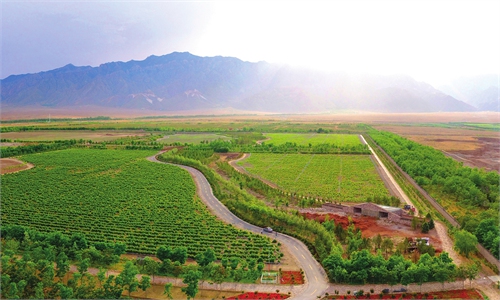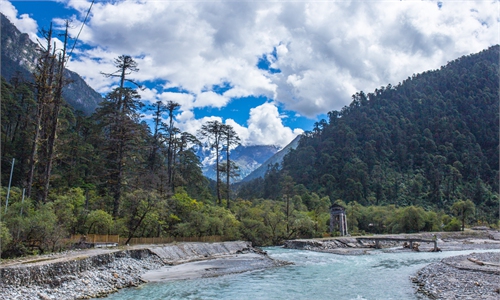
White clouds blanket the Qinling Mountains. Photo: VCG
The Qinling Mountains in Northwest China's Shaanxi Province are a geographically important north-south boundary in China, and an important ecological barrier that plays many functions such as in regulating climate, maintaining soil and water, and preserving biodiversity.Located in the north-south transition zone, the Qinling Mountains are home to more than 2,600 plant and 300 animal species, making it one of the 11 key areas of global biodiversity.
However, the environmental duress faced by the Qinling Mountains has become increasingly serious due to the continuous increase in the conflict between development and environmental protection over the past decades. Driven by selfish interests, the once lush vegetation of the Qinling Mountains was replaced by a cluster of illegal villas; the once wildlife paradise instead turned into a haven for parasites.
Fortunately, the central and local governments of China recognized the problem in time, and have since enforced a series of tough measures to tackle violations: Thousands of illegal villas were demolished, hundreds of mines were closed, and the damaged ecosystem was restored on a large scale... With these continued efforts, the Qinling Mountains are rejuvenated with the vitality of nature.
In October, the plan to create the Qinling Mountains National Park was officially approved by the Chinese National Park Administration. "This is a recognition of our past conservation work and a further large upgrade, giving local people greater confidence and hope," a local official told the Global Times.
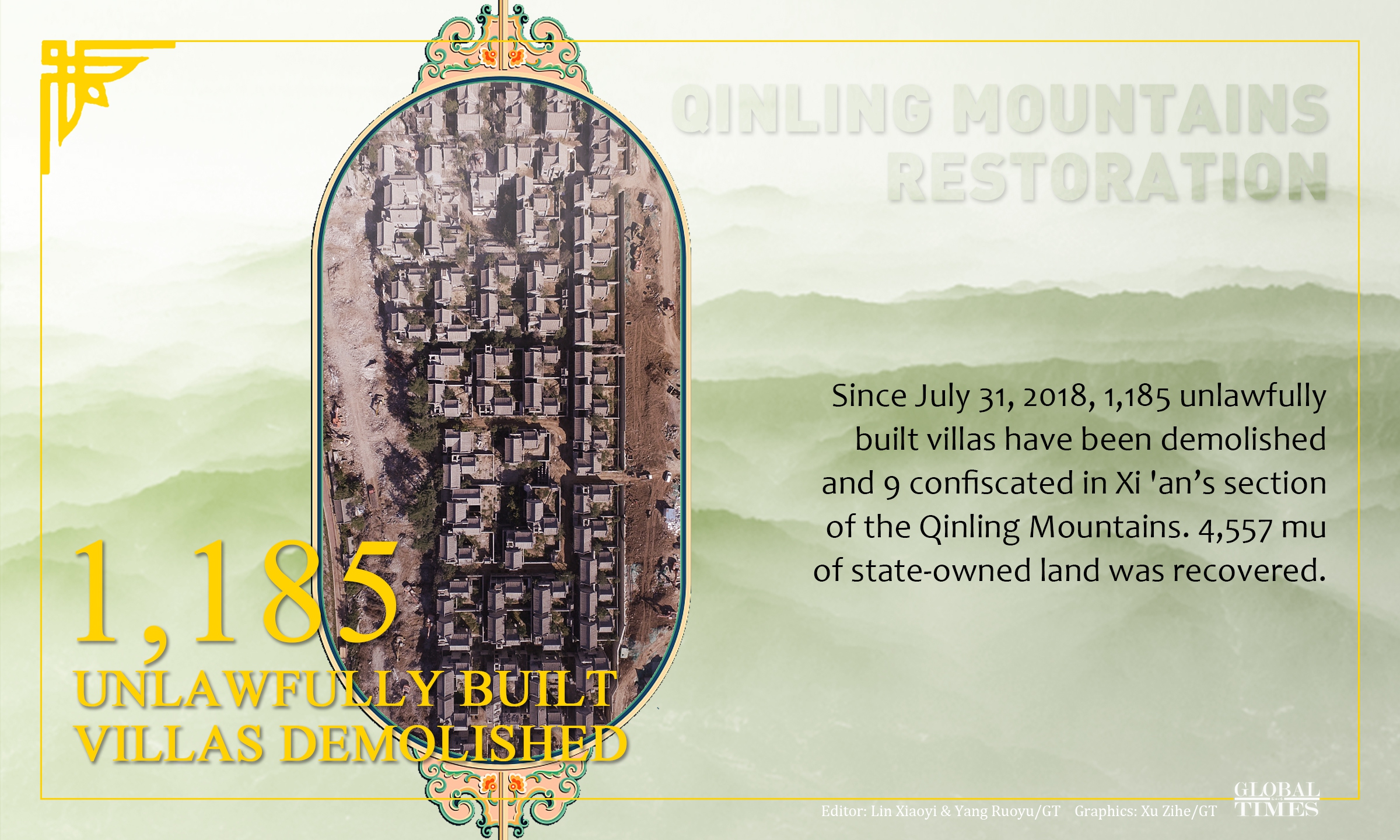
Qinling mountains restoration. Graphic:Xu Zihe/GT
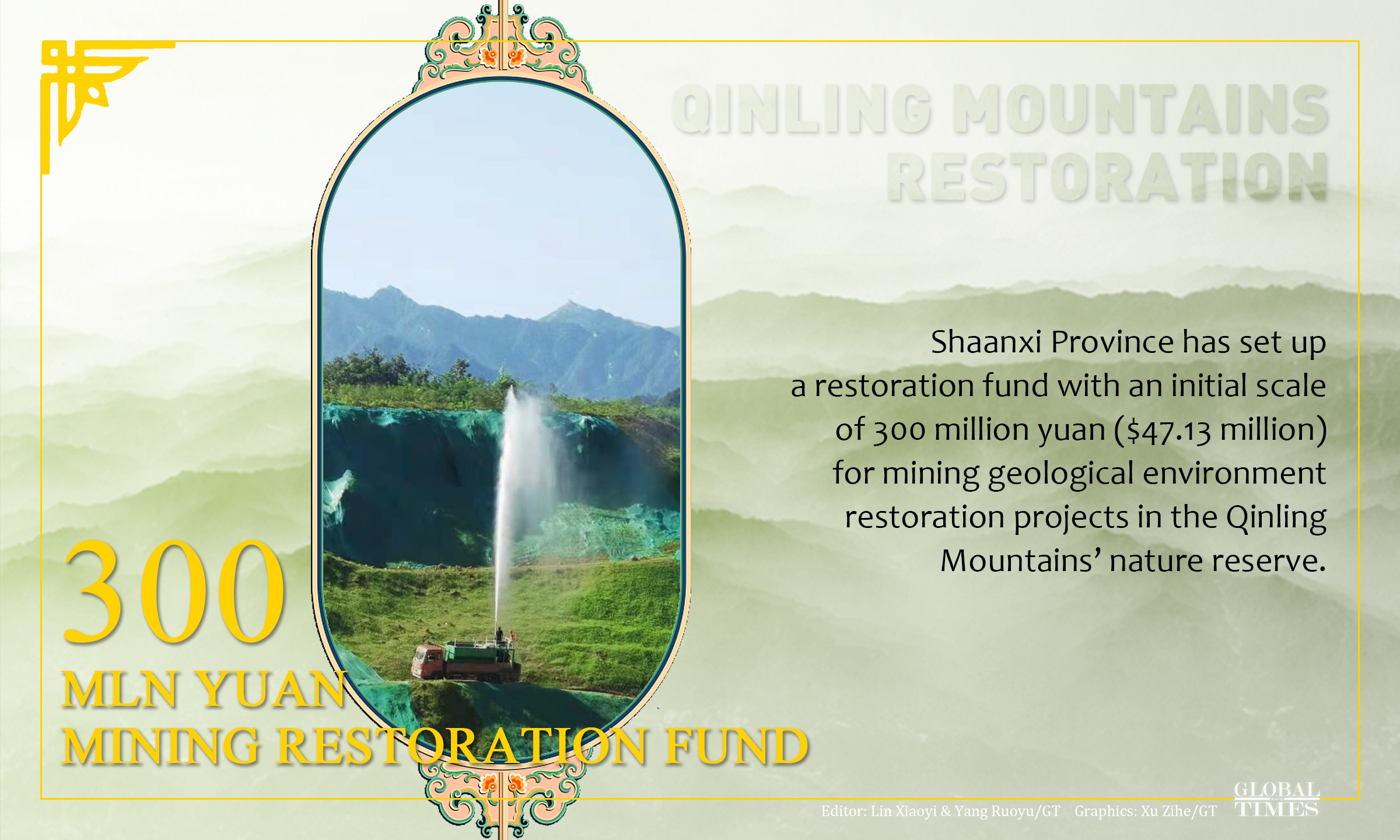
Qinling mountains restoration. Graphic:Xu Zihe/GT
Repair of wounds
It takes only half an hour to drive from urban areas of Xi'an to the foot of the northern foothills of the Qinling Mountains, the slogan "Protect the ecology of the Qinling Mountains" can be seen everywhere along the way, but before 2018, the road leading into the mountains was littered with dazzling "for sale" advertisements for villa properties.
Local people remember how this dramatic change took place, then there was a sensational "Qinling Mountains defend battle." Since July 2018, a total of 1,185 illegally built villas in the Xi'an section of Qinling Mountains have been demolished and the perpetrators punished, resulting in the downfall of a large number of corrupt and law-breaking officials.
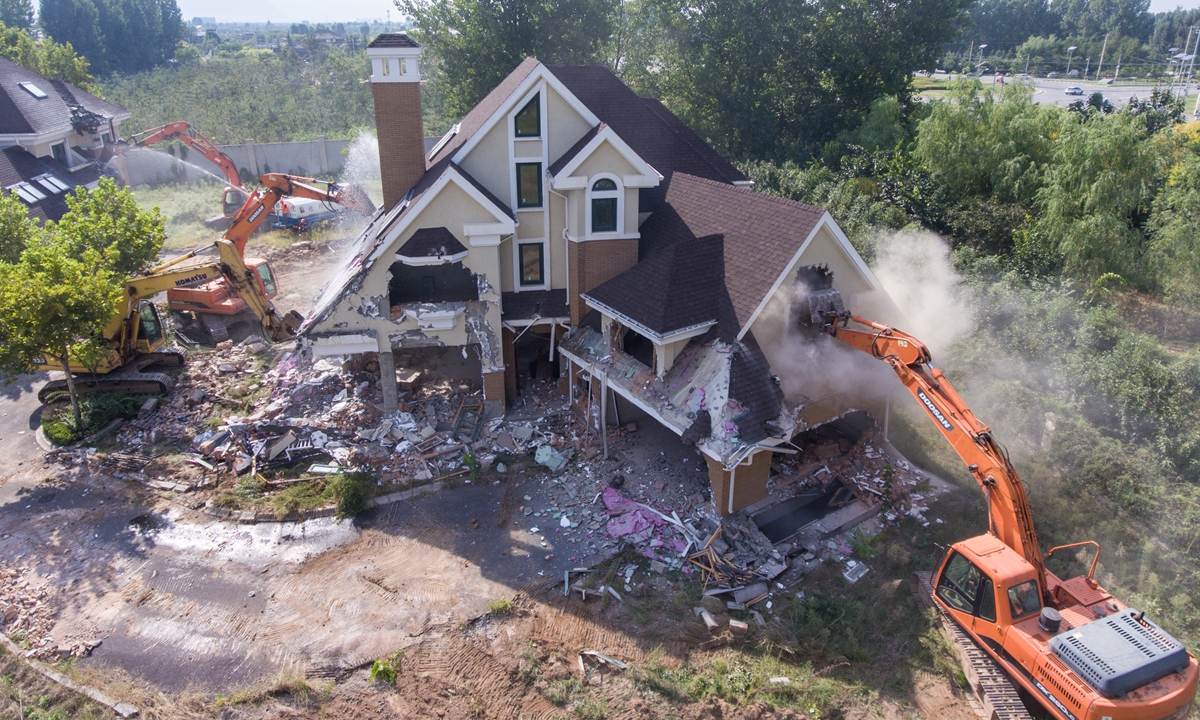
Local authorities in Chang'an district in Xi 'an demolish illegally built villas on September 10, 2018. Photo: IC
Why would a unit of illegal local construction alarm the central government?Since the end of the last century, the Qinling Mountains have attracted many investment projects because of their rich natural and humanistic historical resources. For a long time, although the central and local governments issued policies and regulations to protect the ecological environment of the Qinling Mountains, many people tried to build villas to turn the "national park" into a "private garden," which severely damaged the ecological environment.
In March 2014, the situation of unauthorized construction of villas in the Qinling Mountains damaging the ecological environment was exposed by the media. However, in the face of the central government's rectification instructions, authorities in Shaanxi Province paid no heed, only hastily setting up so-called investigative teams to report the contents and results of the conducted investigations.
Some local officials colluded with developers to trade influence for money, which is an important reason why the illegal villas flourished, a local official told the Global Times.
For example, among the many illegal projects, the owner of Chenlu Villa, which was built under the pretext of a "nursery greenhouse project" with a total area of 78 square meters, is the son of an official who holds a prominent position in the political caste in Xi'an.
Besides, the departments concerned had turned a blind eye to the core problem encouraging further proliferation of illegal villas resulting in increased ecological damage.
Faced with fake investigations, rectification and the inspection of illegal villas in Shaanxi, since July 31, 2018, the central government has sent a special rectification work group to inspect 1,194 unlawfully built villas in Xi'an. Among them, 1,185 were demolished and nine were confiscated according to the law. The Chenlu Villa was also fully demolished and re-greened; a total of 303 hectares of state-owned land was recovered and 217 hectares of collective land was returned to village collectives; and many Party members and cadres were investigated for punishable offences.
After the establishment of the central work group, local development and reform, capital planning, land, environmental protection and other departments jointly conducted a strict re-evaluation of every unauthorized villa project, sorting through every detail carefully, said Xian Shutao, a deputy director of the Chang'an district's Qinling Mountains protection bureau, told the Global Times.
The tight grip on this issue by the Communist Party of China (CPC) reflects " its determination to enforce the protection of ecological spaces with the strictest laws and system," he noted.
With regard to eco-environmental advancement, the CPC Central Committee has devoted greater efforts than ever before to ecological conservation and has made significant progress in building a Beautiful China, said the Communiqué adopted at the Sixth Plenary Session of the 19th Central Committee of the CPC on November 11.
Xian pointed out that the current focus of the protection of the Qinling Mountains' Xi'an section is on the "reinforcement management" -- Consolidating the achievements of past rectification and actively implementing restoration plans.
"Now, through grid management, we have refined the protection work from the city level to district and county levels, and even to every villager group and street," he pointed out.
Currently, many streets in Xi'an innovatively use QR codes to present dynamic information about the illegal construction projects. Anyone who scans the code using their cell phone will be able to access the "causes and consequences" of these projects, making the remediation process more transparent and the management and care work more efficient.
At the same time, local authorities have also actively engaged in remediation and restoration of ecological issues caused by illegal mining, and overcoming difficulties rather than ignoring them.
For example, after the Huangbaiyu open-pit stone mine in Xi'an's Huyi district was decommissioned in 2018 due to encroachment on forest land and ecological damage, local authorities began to increase investment in restoration measures such as specialized seed spraying and mulch planting in areas with poor stand conditions.
For areas with poor plant regrowth, the local protection bureau did not give up, but invited experts to conduct on-site verification to suitably remedy the case.
Until now, in accordance with the upgrading program, the Huyi district Qinling Mountains protection bureau has covered about 130,000 square meters of loess in the original mine area. While the professional engineering team is constructing and restoring the mine, more than 3,000 civil servants have been organized to plant trees at the original mine sites.
At present, the local government has formulated a "one mine, one policy" regulation and has planned to remediate 285 slag treatment facilities in the Qinling Mountains nature reserve and other environmentally sensitive areas, providing a scientific basis for accurate regulation. This year, a total of 61 slag heap environmental protection and safety improvement projects have been completed.
According to media reports, the Shaanxi Provincial Department of Finance and Department of Natural Resources jointly initiated the establishment of the Shaanxi Qinling Mountains Mine Ecological Restoration Fund with an initial scale of 300 million yuan ($47.13million) in September. Currently, the fund is already in a substantive operation stage.
More careful protection
As winter arrives and snowflakes fall in the bamboo forest, a video of the world's rare brown giant panda, Qizai, and his friends sitting comfortably on the ground eating bamboo has gone viral on social media platforms. Netizens were relieved to see Qizai, who was abandoned by his mother after birth, but was well cared for at the Shaanxi Institute of Zoology (Northwest Institute of Endangered Zoological Species) at the foot of the Qinling Mountains.

Brown panda Qizai, the world's rarest giant panda species, plays in the Shaanxi Institute of Zoology. Photo: Courtesy of Shaanxi Institute of Zoology
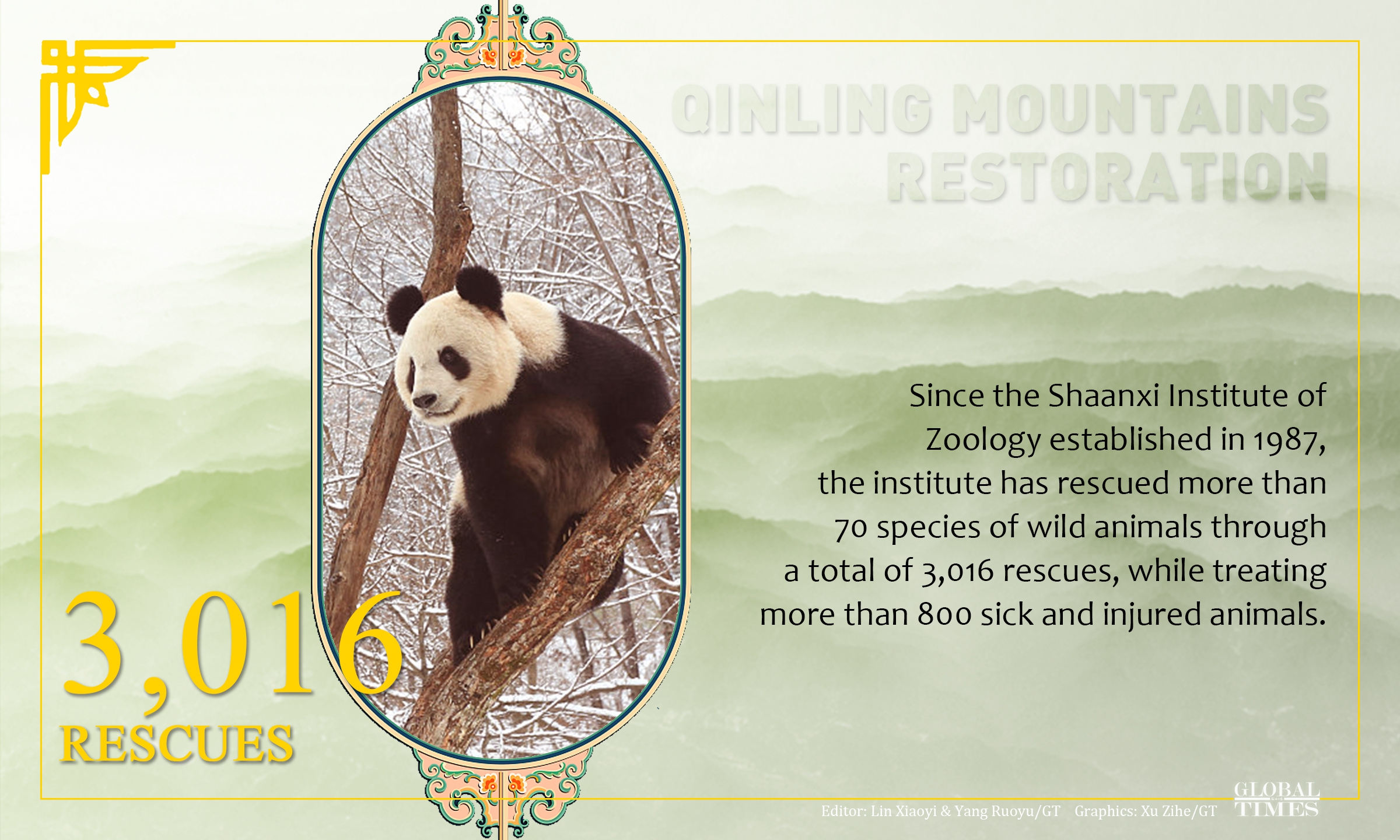
Qinling mountains restoration. Graphic:Xu Zihe/GT
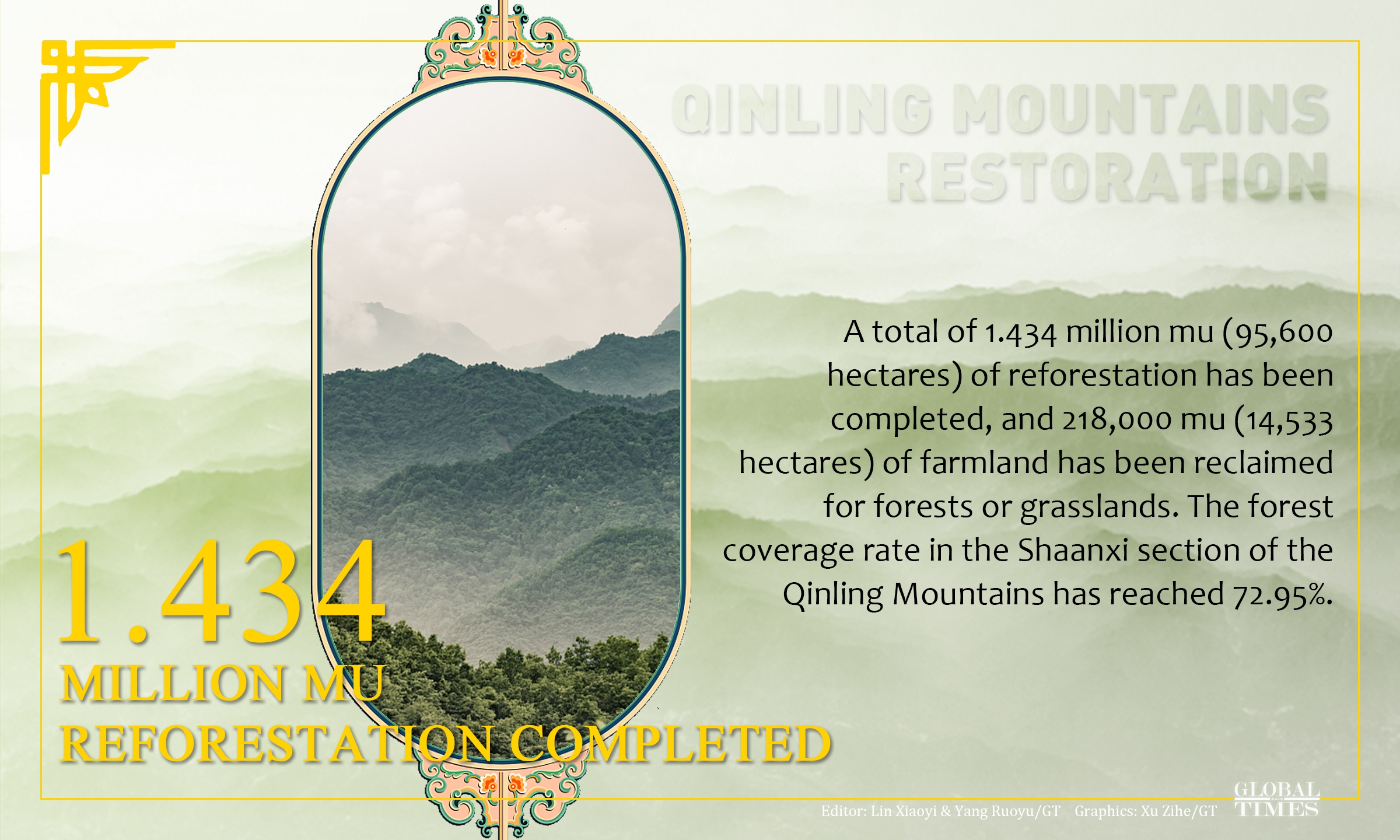
Qinling mountains restoration. Graphic:Xu Zihe/GT
Since its establishment in 1987, the institute has rescued wild animals from more than 70 species through a total of 3,016 rescues, while treating more than 800 sick and injured animals.
The efforts of the institution are just a microcosm of the conservation of flora and fauna in the Qinling Mountains. Over the years, the Chinese government has continued to increase its efforts to protect the ecological environment, and proposed a harmonious coexistence between humans and nature. Local authorities have also combined ground survey, thermal sensing, remote sensing monitoring and drones to form an integrated dynamic monitoring network, which not only strengthens the supervision of construction projects, but also captures the information on the distribution, quantity, and activity pattern of wild animals along the roads in the Qinling Mountains.
"Through these measures, some fragmented information of wildlife habitats will be connected, so that we can carry out protective engineering construction like restoring wetlands and woodlands in a more targeted manner" Wei Yongke, a deputy director of Shaanxi Zhouzhi Heihe River Wetland Provincial Nature Reserve Management Center, told the Global Times, noting that in recent years, the habitat area of many rare plants and animals is expanding, with a steady increase in population size.
Data showed that at present, the population of wild giant panda in Qinling Mountains has increased from 273 to 345 during the past 10 years, with a habitat area of more than 5.4 million acres. The number of ibis in Shaanxi has grown from seven in 1981 to more than 5,000 today.
At the same time, the Chinese government has also commissioned projects like migration and relocation, protection of natural forests, to the reduction of interfering human activities interference, and the restoration and expansion of habitats suitable for the survival of wildlife.
Zhouzhi county, for example, is located at the northern foot of the Qinling Mountains. Due to the limited natural environment, some people living in the mountains were once faced with the dilemma of poor infrastructure and lack of better development opportunities. During the 13th Five-Year Plan period (2016-20), Zhouzhi promoted the relocation work of poverty alleviation, and after 2,099 people moved out of the mountains into new homes.
"People used to live in the mountains by hunting and logging, earning little money and living in poor conditions. With the establishment of the protected area and the implementation of relocation work, the villagers handed in their shotguns, moved into new homes, and joined the community factory to plant kiwi fruit and other cash crops in the designated area. The income of residents has been increased by leaps and bounds," Guo Yirong, a Party branch secretary of Anfuyuan community in Zhouzhi, told the Global Times.
Guo noted that under the continuous publicity and education of the community, there are less poaching of wild animals and deforestation cases. "Wild animals are common to see in the reserve, our villagers will not harm them. If they find them injured or sick, they will contact the local protection station. There are also many villagers who volunteer as rangers during their farming time. Everyone wants to contribute their own part to the green mountains and clear waters of their hometown," she said.

White clouds blanket the Qinling Mountains. Photo: VCG
The Qinling Mountains in Northwest China's Shaanxi Province are a geographically important north-south boundary in China, and an important ecological barrier that plays many functions such as in regulating climate, maintaining soil and water, and preserving biodiversity.Located in the north-south transition zone, the Qinling Mountains are home to more than 2,600 plant and 300 animal species, making it one of the 11 key areas of global biodiversity.
However, the environmental duress faced by the Qinling Mountains has become increasingly serious due to the continuous increase in the conflict between development and environmental protection over the past decades. Driven by selfish interests, the once lush vegetation of the Qinling Mountains was replaced by a cluster of illegal villas; the once wildlife paradise instead turned into a haven for parasites.
Fortunately, the central and local governments of China recognized the problem in time, and have since enforced a series of tough measures to tackle violations: Thousands of illegal villas were demolished, hundreds of mines were closed, and the damaged ecosystem was restored on a large scale... With these continued efforts, the Qinling Mountains are rejuvenated with the vitality of nature.
In October, the plan to create the Qinling Mountains National Park was officially approved by the Chinese National Park Administration. "This is a recognition of our past conservation work and a further large upgrade, giving local people greater confidence and hope," a local official told the Global Times.

Qinling mountains restoration. Graphic:Xu Zihe/GT

Qinling mountains restoration. Graphic:Xu Zihe/GT
Repair of wounds
It takes only half an hour to drive from urban areas of Xi'an to the foot of the northern foothills of the Qinling Mountains, the slogan "Protect the ecology of the Qinling Mountains" can be seen everywhere along the way, but before 2018, the road leading into the mountains was littered with dazzling "for sale" advertisements for villa properties.
Local people remember how this dramatic change took place, then there was a sensational "Qinling Mountains defend battle." Since July 2018, a total of 1,185 illegally built villas in the Xi'an section of Qinling Mountains have been demolished and the perpetrators punished, resulting in the downfall of a large number of corrupt and law-breaking officials.

Local authorities in Chang'an district in Xi 'an demolish illegally built villas on September 10, 2018. Photo: IC
Why would a unit of illegal local construction alarm the central government?Since the end of the last century, the Qinling Mountains have attracted many investment projects because of their rich natural and humanistic historical resources. For a long time, although the central and local governments issued policies and regulations to protect the ecological environment of the Qinling Mountains, many people tried to build villas to turn the "national park" into a "private garden," which severely damaged the ecological environment.
In March 2014, the situation of unauthorized construction of villas in the Qinling Mountains damaging the ecological environment was exposed by the media. However, in the face of the central government's rectification instructions, authorities in Shaanxi Province paid no heed, only hastily setting up so-called investigative teams to report the contents and results of the conducted investigations.
Some local officials colluded with developers to trade influence for money, which is an important reason why the illegal villas flourished, a local official told the Global Times.
For example, among the many illegal projects, the owner of Chenlu Villa, which was built under the pretext of a "nursery greenhouse project" with a total area of 78 square meters, is the son of an official who holds a prominent position in the political caste in Xi'an.
Besides, the departments concerned had turned a blind eye to the core problem encouraging further proliferation of illegal villas resulting in increased ecological damage.
Faced with fake investigations, rectification and the inspection of illegal villas in Shaanxi, since July 31, 2018, the central government has sent a special rectification work group to inspect 1,194 unlawfully built villas in Xi'an. Among them, 1,185 were demolished and nine were confiscated according to the law. The Chenlu Villa was also fully demolished and re-greened; a total of 303 hectares of state-owned land was recovered and 217 hectares of collective land was returned to village collectives; and many Party members and cadres were investigated for punishable offences.
After the establishment of the central work group, local development and reform, capital planning, land, environmental protection and other departments jointly conducted a strict re-evaluation of every unauthorized villa project, sorting through every detail carefully, said Xian Shutao, a deputy director of the Chang'an district's Qinling Mountains protection bureau, told the Global Times.
The tight grip on this issue by the Communist Party of China (CPC) reflects " its determination to enforce the protection of ecological spaces with the strictest laws and system," he noted.
With regard to eco-environmental advancement, the CPC Central Committee has devoted greater efforts than ever before to ecological conservation and has made significant progress in building a Beautiful China, said the Communiqué adopted at the Sixth Plenary Session of the 19th Central Committee of the CPC on November 11.
Xian pointed out that the current focus of the protection of the Qinling Mountains' Xi'an section is on the "reinforcement management" -- Consolidating the achievements of past rectification and actively implementing restoration plans.
"Now, through grid management, we have refined the protection work from the city level to district and county levels, and even to every villager group and street," he pointed out.
Currently, many streets in Xi'an innovatively use QR codes to present dynamic information about the illegal construction projects. Anyone who scans the code using their cell phone will be able to access the "causes and consequences" of these projects, making the remediation process more transparent and the management and care work more efficient.
At the same time, local authorities have also actively engaged in remediation and restoration of ecological issues caused by illegal mining, and overcoming difficulties rather than ignoring them.
For example, after the Huangbaiyu open-pit stone mine in Xi'an's Huyi district was decommissioned in 2018 due to encroachment on forest land and ecological damage, local authorities began to increase investment in restoration measures such as specialized seed spraying and mulch planting in areas with poor stand conditions.
For areas with poor plant regrowth, the local protection bureau did not give up, but invited experts to conduct on-site verification to suitably remedy the case.
Until now, in accordance with the upgrading program, the Huyi district Qinling Mountains protection bureau has covered about 130,000 square meters of loess in the original mine area. While the professional engineering team is constructing and restoring the mine, more than 3,000 civil servants have been organized to plant trees at the original mine sites.
At present, the local government has formulated a "one mine, one policy" regulation and has planned to remediate 285 slag treatment facilities in the Qinling Mountains nature reserve and other environmentally sensitive areas, providing a scientific basis for accurate regulation. This year, a total of 61 slag heap environmental protection and safety improvement projects have been completed.
According to media reports, the Shaanxi Provincial Department of Finance and Department of Natural Resources jointly initiated the establishment of the Shaanxi Qinling Mountains Mine Ecological Restoration Fund with an initial scale of 300 million yuan ($47.13million) in September. Currently, the fund is already in a substantive operation stage.
More careful protection
As winter arrives and snowflakes fall in the bamboo forest, a video of the world's rare brown giant panda, Qizai, and his friends sitting comfortably on the ground eating bamboo has gone viral on social media platforms. Netizens were relieved to see Qizai, who was abandoned by his mother after birth, but was well cared for at the Shaanxi Institute of Zoology (Northwest Institute of Endangered Zoological Species) at the foot of the Qinling Mountains.

Brown panda Qizai, the world's rarest giant panda species, plays in the Shaanxi Institute of Zoology. Photo: Courtesy of Shaanxi Institute of Zoology

Qinling mountains restoration. Graphic:Xu Zihe/GT

Qinling mountains restoration. Graphic:Xu Zihe/GT
Since its establishment in 1987, the institute has rescued wild animals from more than 70 species through a total of 3,016 rescues, while treating more than 800 sick and injured animals.
The efforts of the institution are just a microcosm of the conservation of flora and fauna in the Qinling Mountains. Over the years, the Chinese government has continued to increase its efforts to protect the ecological environment, and proposed a harmonious coexistence between humans and nature. Local authorities have also combined ground survey, thermal sensing, remote sensing monitoring and drones to form an integrated dynamic monitoring network, which not only strengthens the supervision of construction projects, but also captures the information on the distribution, quantity, and activity pattern of wild animals along the roads in the Qinling Mountains.
"Through these measures, some fragmented information of wildlife habitats will be connected, so that we can carry out protective engineering construction like restoring wetlands and woodlands in a more targeted manner" Wei Yongke, a deputy director of Shaanxi Zhouzhi Heihe River Wetland Provincial Nature Reserve Management Center, told the Global Times, noting that in recent years, the habitat area of many rare plants and animals is expanding, with a steady increase in population size.
Data showed that at present, the population of wild giant panda in Qinling Mountains has increased from 273 to 345 during the past 10 years, with a habitat area of more than 5.4 million acres. The number of ibis in Shaanxi has grown from seven in 1981 to more than 5,000 today.
At the same time, the Chinese government has also commissioned projects like migration and relocation, protection of natural forests, to the reduction of interfering human activities interference, and the restoration and expansion of habitats suitable for the survival of wildlife.
Zhouzhi county, for example, is located at the northern foot of the Qinling Mountains. Due to the limited natural environment, some people living in the mountains were once faced with the dilemma of poor infrastructure and lack of better development opportunities. During the 13th Five-Year Plan period (2016-20), Zhouzhi promoted the relocation work of poverty alleviation, and after 2,099 people moved out of the mountains into new homes.
"People used to live in the mountains by hunting and logging, earning little money and living in poor conditions. With the establishment of the protected area and the implementation of relocation work, the villagers handed in their shotguns, moved into new homes, and joined the community factory to plant kiwi fruit and other cash crops in the designated area. The income of residents has been increased by leaps and bounds," Guo Yirong, a Party branch secretary of Anfuyuan community in Zhouzhi, told the Global Times.
Guo noted that under the continuous publicity and education of the community, there are less poaching of wild animals and deforestation cases. "Wild animals are common to see in the reserve, our villagers will not harm them. If they find them injured or sick, they will contact the local protection station. There are also many villagers who volunteer as rangers during their farming time. Everyone wants to contribute their own part to the green mountains and clear waters of their hometown," she said.
